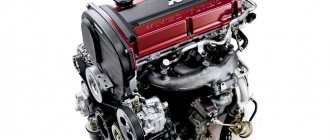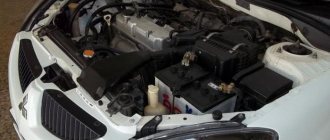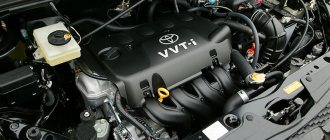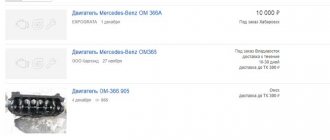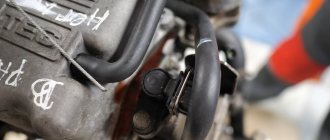According to the regulations of the Mitsubishi manufacturer, the 4G69 engine does not contain direct information about its parameters in its designation. The marking is deciphered as follows:
- 4 – number of cylinders;
- G – fuel type (petrol or Gasoline in English);
- 6 – Sirius series with cast iron block;
- 9 – motor version number within the series (latest).
ICE 4G69
The manufacturer has three more “star” series of engines – Astron, Saturn and Orion. In its series, version 4G69 is the final model of the series. Since 2013, Mitsubishi has been using more modern 4B12 engines, and the older version 4G69 is used by Chinese automakers who have officially received a license for it.
To provide torque of 219 Nm and power of 165 hp. With. The four-cylinder naturally aspirated engine uses the following technical solutions:
- in-line engine diagram with a cast iron block;
- SOHC timing mechanism;
- MIVEC phase control technology;
- long-stroke ShPG with a piston stroke of 100 mm and a cylinder diameter of 87 mm.
MIVEC system
An important feature is the piston/valve collision when the timing belt breaks. In other words, the 4G69 engine bends the valves at speeds of 3200 min-1. If a break occurs in idle mode, the geometry of the valve stems may remain intact without damage.
In fact, the 4G69 version of the internal combustion engine is a boost of the 4G64 engine for the 2003 Outlander and Grandis cars manufactured by Mitsubishi. The modernization was carried out with the sole purpose of increasing the power of the power drive for heavy Mitsubishi models. The full technical specifications of 4G69 are as follows:
| Manufacturer | Mitsubishi |
| Engine brand | 4G69 |
| Years of production | 2003 – 2013 |
| Volume | 2378 cm3 (2.4 l) |
| Power | 121.4 kW (165 hp) |
| Torque moment | 219 Nm (at 4200 rpm) |
| Weight | 192 kg |
| Compression ratio | 9.5 (11.5 GDI) |
| Nutrition | injector |
| Motor type | in-line petrol |
| Ignition | DIS-2 |
| Number of cylinders | 4 |
| Location of the first cylinder | TVE |
| Number of valves on each cylinder | 4 |
| Cylinder head material | aluminum alloy |
| Intake manifold | aluminum casting |
| An exhaust manifold | cast iron |
| Camshaft | cast |
| Cylinder block material | cast iron |
| Cylinder diameter | 87 mm |
| Pistons | lightweight |
| Crankshaft | lightweight |
| Piston stroke | 100 mm |
| Fuel | AI-95 |
| Environmental standards | Euro 5 |
| Fuel consumption | highway – 7.2 l/100 km combined cycle 9.5 l/100 km city – 13.5 l/100 km |
| Oil consumption | 0.6 – 0.8 l/1000 km |
| What kind of oil to pour into the engine by viscosity | 5W30, 5W40, 0W30, 10W30, 10W40, 5W50, 10W50, 15W50 |
| Which engine oil is best by manufacturer | Liqui Moly |
| Oil for 4G69 by composition | synthetics, semi-synthetics |
| Engine oil volume | 4.3 l |
| Operating temperature | 95° |
| ICE resource | declared 350,000 km actual 400,000 km |
| Adjustment of valves | nuts |
| Cooling system | forced, antifreeze |
| Coolant volume | 7 l |
| water pump | NA4W, MW1454 |
| Spark plugs for 4G69 | LZFR6AI from NGK |
| Spark plug gap | 0.8 – 1.1 mm |
| Timing belt | 1145A008 |
| Balancer shaft belt | MR984778 |
| Cylinder operating order | 1-3-4-2 |
| Air filter | Jakoparts J1325050, Fram CA10910, Filtron AP120/5, Fiaam PA7691, Bosch F026400353, Alco MD-8726 |
| Oil filter | Bosch F00E369835, F002H60004, 0986TF0059 |
| Flywheel | 7 mounting holes |
| Flywheel mounting bolts | M12x1.25 mm, length 26 mm |
| Valve stem seals | manufacturer Goetze |
| Compression | from 12 bar, difference in adjacent cylinders maximum 1 bar |
| XX speed | 850 – 900 min-1 |
| Tightening force of threaded connections | spark plug – 31 – 39 Nm flywheel – 62 – 87 Nm clutch bolt – 19 – 30 Nm bearing cap – 68 – 83 Nm (main) and 43 – 53 (rod) cylinder head – 4 stages 20 Nm, 69 – 85 Nm + 90° + 90° |
The official manual not only contains a description of the parameters, but also clearly defined periods for replacing lubricants and consumables. Here are step-by-step instructions so you can complete major garage renovations on your own.
Design Features
The 4G69 engine was designed based on an earlier version of the same 4G64 series. The main design nuances were:
- long piston stroke of 100 mm, which required lightening the connecting rods from 623 to 530 g, the crankshaft from 15.8 to 14.9 kg and the pistons from 354 to 278 g;
- cylinder volumes increased to 2.4 liters, made of cast iron liners inside a block made of the same material;
- reducing the block height to 284 mm while simultaneously increasing the cylinder diameter to 87 mm;
- single-shaft SOHC 16V cylinder head with integrated MIVEC system;
- increase in valve size to 30.5 mm and 34 mm (intake, exhaust, respectively);
- timing drive by a narrow toothed belt with a service life of about 90,000 km;
- the presence of one balancing shaft with a belt drive;
- EGR exhaust recirculation system, which increases the European protocol for the environmental friendliness of the engine, but reduces the power and resource of the intake tract.
Cylinder block 4G69
Cylinder head 4G69
An important feature of the atmospheric version of 4G69 was the modified attachments. First, management changed the design of the intake tract, then the exhaust manifold had to be modernized. This power drive does not have a turbo version, but there is potential for inflatable and mechanical tuning with your own hands.
The MIVEC system was designed to increase engine power by 13%:
- 8% due to controlled valve lift;
- 2.5% due to accelerated supply of the fuel mixture;
- 1.5% due to reduced resistance in the exhaust valves;
- 1% due to a slight increase in the volume of the combustion chambers.
As a result of testing, additional bonuses were revealed - stable operation of the internal combustion engine, increased environmental standards and fuel economy. On the other hand, the fluid coupling is sensitive to the quality of the oil.
A single-shaft SOHC timing system for controlling 16 valves is not the simplest technical solution. This also reduces the service life and maintainability of the motor. Every 30 - 40 thousand kilometers the valve thermal clearances have to be adjusted.
ShPG 4G69
In the 4G6 series (Sirius), this power drive is the only one equipped with a phase control system. There are no official modifications to this engine.
Reliability, problems and repair of the Mitsubishi 4G69 2.4 liter engine.
An updated version of the 4G64, under the name 4G69, was released in 2003 on Mitsubishi Grandis and Mitsubishi Outlander cars and became the latest representative of the Sirius engine family (which, in addition to our engine, also included: 4G63T, 4G61, 4G62, 4G63, 4G64, 4G67, 4G69, 4D65 and 4D68). In the new engine, the height of the cylinder block was reduced to 229 mm relative to its predecessor, the cylinder diameter was increased to 87 mm (it was 86.5 mm), lightweight pistons were installed (278 g versus 354 g on the 4G64), a lightweight crankshaft (14.9 kg versus 15.8 kg on the 4G64 ) and connecting rods (530 g versus 623 g). A new cylinder head was installed, with a variable valve timing system on the intake shaft and valve lift MIVEC, the diameter of the intake valves increased to 34 mm, and the exhaust valves to 30.5 mm. There are no hydraulic compensators on the 4G69, so every 40-50 thousand km it is necessary to adjust the valves, the intake valve clearances when hot are 0.2 mm, the exhaust valves are 0.3 mm.
In addition, a version with GDI direct fuel injection was also produced; the compression ratio on such engines was increased to 11.5. The intake manifold was completely redesigned, and along with it, the exhaust manifold also underwent modifications. The timing belt drive, the belt width was reduced, the service life remained the same, about 90 thousand km. Along with the belt, the balancing shaft belt also changes.
Currently, the 4G69 engine is produced under license for automobile companies from China, and Mitsubishi itself installs a more modern version 4B12 instead.
Problems and disadvantages of Mitsubishi 4G69 2.4 liter engines.
In terms of illnesses and malfunctions, the 4G69 resembles the 4G63, however, problems with vibration are now observed much less frequently; on the other hand, a more modern engine loves high-quality gasoline and saving on it will, at a minimum, lead to an early replacement of the catalyst. Otherwise, the engine is excellent, careful treatment, high-quality oil, gasoline and regular maintenance will ensure maximum trouble-free operation; the 4G69 resource in this mode can exceed 400 thousand km.
Advantages and disadvantages
The complex design of the internal combustion engine ensured high performance properties - torque of 219 Nm and power of 165 hp. With. The disadvantages of the design were:
- high requirements for fuel/lubricant quality sharply increase the operating budget;
- after 30 - 40 thousand mileage, a visit to the service station is necessary to adjust the valve clearances;
- the attachment partly has a low resource (pump, catalyst, fuel pump).
Pump 4G69
On the other hand, the engine characteristics are initially high, there are no power dips at medium speeds. The service life is over 400,000 km, and taking into account several re-liners, the engine can be classified as a “million-dollar”.
Repairs and tuning can be done on your own; the attachment is well arranged and does not interfere with engine maintenance.
Technical characteristics and design
The 4G69 is a popular engine from Mitsubishi Motors, and a continuation of the popular 4G64 engine. Among the changes, one can note the increased height of the cylinder block.
Mitsubishi 4G69 engine on the Evolution hood.
The designers increased the cylinder diameter to 87 mm (it was 86.5 mm), installed lightweight pistons (278 g versus 354 g on 4G64), a lightweight crankshaft (14.9 kg versus 15.8 kg on 4G64) and connecting rods (530 g versus 623 g).
A new cylinder head was installed, with a variable valve timing system on the intake shaft and valve lift MIVEC, the diameter of the intake valves increased to 34 mm, and the exhaust valves to 30.5 mm.
There are no hydraulic compensators on the 4G69, so every 40-50 thousand km it is necessary to adjust the valves, the intake valve clearances when hot are 0.2 mm, the exhaust valves are 0.3 mm.
Technical characteristics of the 4G69 motor:
Motor 4G69.
| Name | Characteristics |
| Manufacturer | Shiga Plant |
| Motor brand | 4G69 |
| Volume | 2.4 liters (2378 cm3) |
| Injection | Injector |
| Power | 160-165 hp |
| Cylinder diameter | 87 mm |
| Number of cylinders | 4 |
| Number of valves | 16 |
| Fuel consumption | 9.5 liters for every 100 km in mixed mode |
| Engine oil | |
| Resource | 400+ thousand km |
| Applicability |
List of car models in which it was installed
From 2003 to the present day, the 4G69 engine has been mounted on the following models of Mitsubishi:
- Grandis – 2003 – 20111, minivan;
- Lancer – 2004 – 2006, station wagon and sedan;
- Outlander – 2004 – 2006, original crossover;
- Galant – 2004 – 2012, sedan with a sporty exterior;
- Eclipse – 2006 – 2012, sports car in a coupe body;
- Zinger – since 2008, mid-size minivan.
Mitsubishi Galant
The power drive is installed in Chinese cars H3 and H5 from Great Wall Haval and the full-size BYD S6 crossover and Geely EC-8 sedan. 4G69 is used in budget Chinese all-wheel drive Geely EC8 pickups and Hawtai Terracan SUVs.
Maintenance schedule 4G69 2.4 l/165 l. With.
The naturally aspirated 4G69 engine, which is sensitive to the quality of oil and gasoline, should be maintained especially carefully:
- The timing belt drive is replaced after 90,000 km, attachments after 50,000 km;
- it is recommended to adjust the thermal clearances of the valves after 30,000 miles;
- cleaning of the crankcase ventilation is provided by the manufacturer every 2 years;
- the developer recommends replacing the engine oil and filter every 10,000 km;
- the fuel filter is changed after 20,000 mileage;
- the manufacturer's manual states that the air filter must be updated annually;
- additives from the factory inside the antifreeze lose their properties after 40,000 km;
- the life of spark plugs in the DIS-2 engine system is limited to 20,000 mileage;
- the intake manifold begins to burn out in some areas after 60,000 km, and the insides of the catalytic converter begin to crumble.
4G69 service
In Russia, the octane number usually does not correspond to that stated by the supplier on the price tag of the product, therefore the 4G69 should be operated on at least AI-95 gasoline.
Technical specifications 4G69 2.4 l165 l. With.
To provide torque of 219 Nm and power of 165 hp. With. The four-cylinder naturally aspirated engine uses the following technical solutions:
- in-line engine diagram with a cast iron block;
- SOHC timing mechanism;
- MIVEC phase control technology;
- long-stroke ShPG with a piston stroke of 100 mm and a cylinder diameter of 87 mm.
MIVEC system
In fact, the 4G69 version of the internal combustion engine is a boost of the 4G64 engine for the 2003 Outlander and Grandis cars manufactured by Mitsubishi. The modernization was carried out with the sole purpose of increasing the power of the power drive for heavy Mitsubishi models. The full technical specifications of 4G69 are as follows:
| Manufacturer | Mitsubishi |
| Engine brand | 4G69 |
| Years of production | 2003 – 2013 |
| Volume | 2378 cm3 (2.4 l) |
| Power | 121.4 kW (165 hp) |
| Torque moment | 219 Nm (at 4200 rpm) |
| Weight | 192 kg |
| Compression ratio | 9.5 (11.5 GDI) |
| Nutrition | injector |
| Motor type | in-line petrol |
| Ignition | DIS-2 |
| Number of cylinders | 4 |
| Location of the first cylinder | TVE |
| Number of valves on each cylinder | 4 |
| Cylinder head material | aluminum alloy |
| Intake manifold | aluminum casting |
| An exhaust manifold | cast iron |
| Camshaft | cast |
| Cylinder block material | cast iron |
| Cylinder diameter | 87 mm |
| Pistons | lightweight |
| Crankshaft | lightweight |
| Piston stroke | 100 mm |
| Fuel | AI-95 |
| Environmental standards | Euro 5 |
| Fuel consumption | highway – 7.2 l/100 km combined cycle 9.5 l/100 km city – 13.5 l/100 km |
| Oil consumption | 0.6 – 0.8 l/1000 km |
| What kind of oil to pour into the engine by viscosity | 5W30, 5W40, 0W30, 10W30, 10W40, 5W50, 10W50, 15W50 |
| Which engine oil is best by manufacturer | Liqui Moly |
| Oil for 4G69 by composition | synthetics, semi-synthetics |
| Engine oil volume | 4.3 l |
| Operating temperature | 95° |
| ICE resource | declared 350,000 km actual 400,000 km |
| Adjustment of valves | nuts |
| Cooling system | forced, antifreeze |
| Coolant volume | 7 l |
| water pump | NA4W, MW1454 |
| Spark plugs for 4G69 | LZFR6AI from NGK |
| Spark plug gap | 0.8 – 1.1 mm |
| Timing belt | 1145A008 |
| Balancer shaft belt | MR984778 |
| Cylinder operating order | 1-3-4-2 |
| Air filter | Jakoparts J1325050, Fram CA10910, Filtron AP120/5, Fiaam PA7691, Bosch F026400353, Alco MD-8726 |
| Oil filter | Bosch F00E369835, F002H60004, 0986TF0059 |
| Flywheel | 7 mounting holes |
| Flywheel mounting bolts | M12x1.25 mm, length 26 mm |
| Valve stem seals | manufacturer Goetze |
| Compression | from 12 bar, difference in adjacent cylinders maximum 1 bar |
| XX speed | 850 – 900 min-1 |
| Tightening force of threaded connections | spark plug – 31 – 39 Nm flywheel – 62 – 87 Nm clutch bolt – 19 – 30 Nm bearing cap – 68 – 83 Nm (main) and 43 – 53 (rod) cylinder head – 4 stages 20 Nm, 69 – 85 Nm + 90° + 90° |
Review of faults and methods for repairing them
At high speeds, that is, in motion, the 4G69 engine is 100% likely to bend the valves with the ICE pistons meeting them. Other malfunctions include the following cases:
| Idle speed is not stable | 1) IAC failure 2) contamination of the throttle valve 3) temperature sensor failure 4) clogged injectors | 1) replacing the idle air control 2) cleaning the throttle 3) replacement of diesel fuel 4) washing the injectors on the bench or replacing them |
| Vibrations | 1) wear of the cushion, usually the left one 2) stuck rings inside one cylinder | 1) replacing the pillow 2) decarbonizing, replacing rings |
| Broken timing belt during the overhaul period | 1) failure of the balancing shaft bearing 2) poor quality of lubrication, jamming of the balancer, breakage of the BV belt | 1) bearing replacement 2) replacement |
Repair 4G69
The owner of a car with a 4G69 engine should understand that the resources of most units are interconnected with each other. The lowest of them are at the rollers and the balancer shaft bearing, so along with these consumables it is necessary to change the balancer belt and timing belt at the same time.
